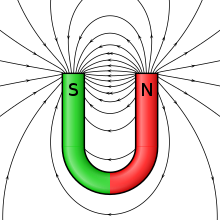Hufeisenmagnet


Als Hufeisenmagnet bezeichnet man einen Magneten, der ungefähr die Form eines Hufeisens hat. Den Hufeisenmagneten zeichnet insbesondere das stark konzentrierte Magnetfeld zwischen seinen Schenkeln aus. Abseits der beiden Pole fällt das Magnetfeld schnell ab. Ein Hufeisenmagnet ist im Prinzip ein gebogener Stabmagnet.
Fachliteratur
- Das große Buch der Technik. Verlag für Wissen und Bildung (Verlagsgruppe Bertelsmann), Gütersloh 1972.
- Günter Springer: Fachkunde Elektrotechnik. 18. Auflage. Verlag – Europa – Lehrmittel, Wuppertal 1989. ISBN 3-8085-3018-9.
Weblinks
Auf dieser Seite verwendete Medien
Autor/Urheber: Geek3, Lizenz: CC BY-SA 4.0
Drawing of a horseshoe magnet with precisely computed magnetic field lines. The horseshoe magnet is assumed as a curved cylindrical rod with constant magnetisation along the cylinder axis. North- and southpole of the magnet are marked in red and green, respectively. The shape of the magnetic field is computed as follows: H- and B-field are identical in free space, so we can choose the easier one, which is the H-field. The H-field has its sources and sinks where the lines of the magnetisation end and begin. Thus, the correct field is obtained by placing magnetic charges at the surfaces of the two magnetic poles. The field of a charge disc distribution is obtained by numerical integration. The shape of the field lines is traced with a Runge-Kutta algorithm. The density of field lines corresponds roughly to the field strength, however due to 3D variations of the field, this cannot exactly be fulfilled.
Note that in measured field distributions, e.g. using magnetised iron filings the field shape in the lower part of the image (where the magnet is bent) may somewhat differ. This is because the total field strength is very weak there. Therefore any inhomogeneity in the magnetisation can strongly alter the field direction.
Autor/Urheber: Oguraclutch, Lizenz: CC BY-SA 3.0
Construction

